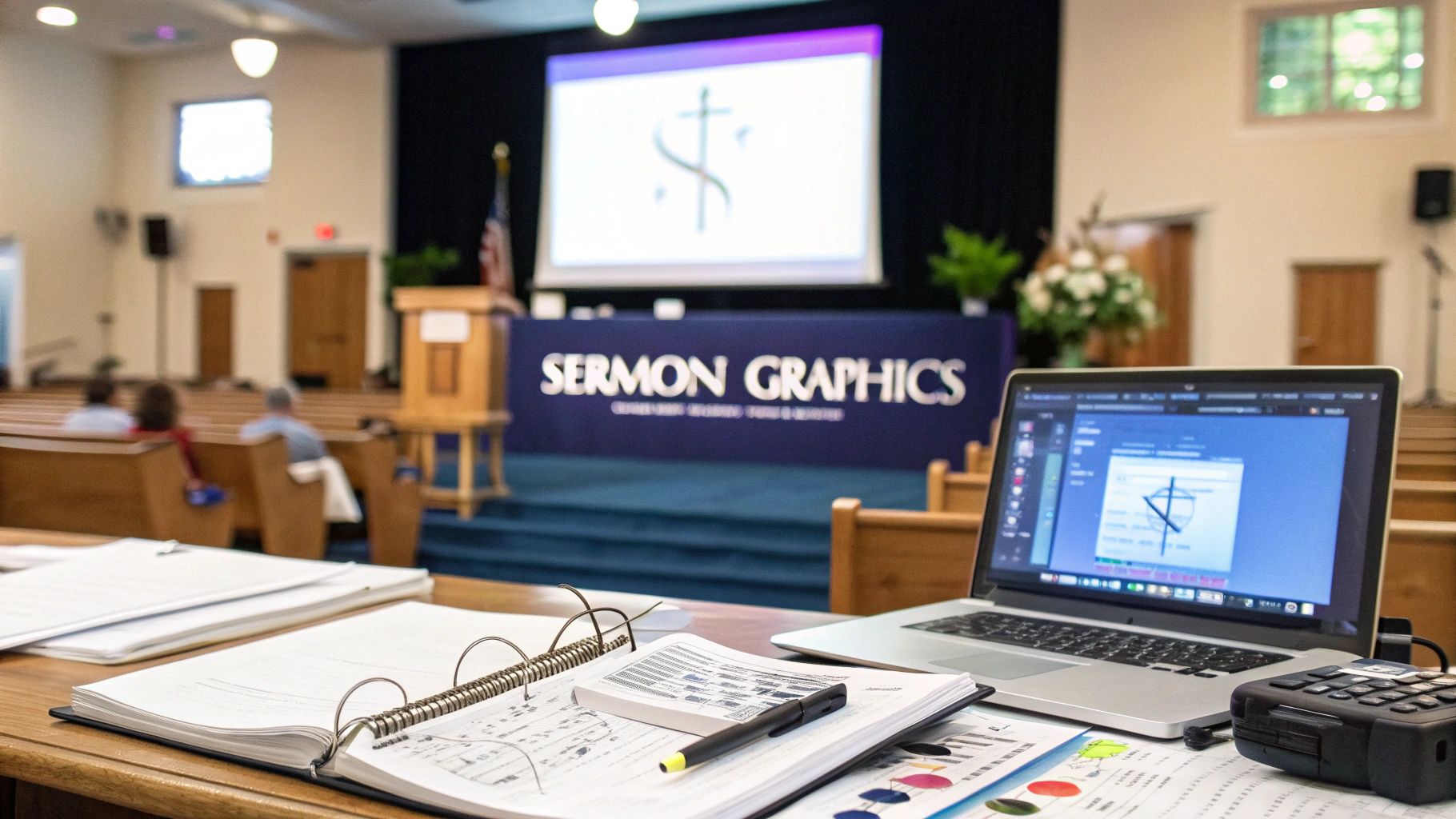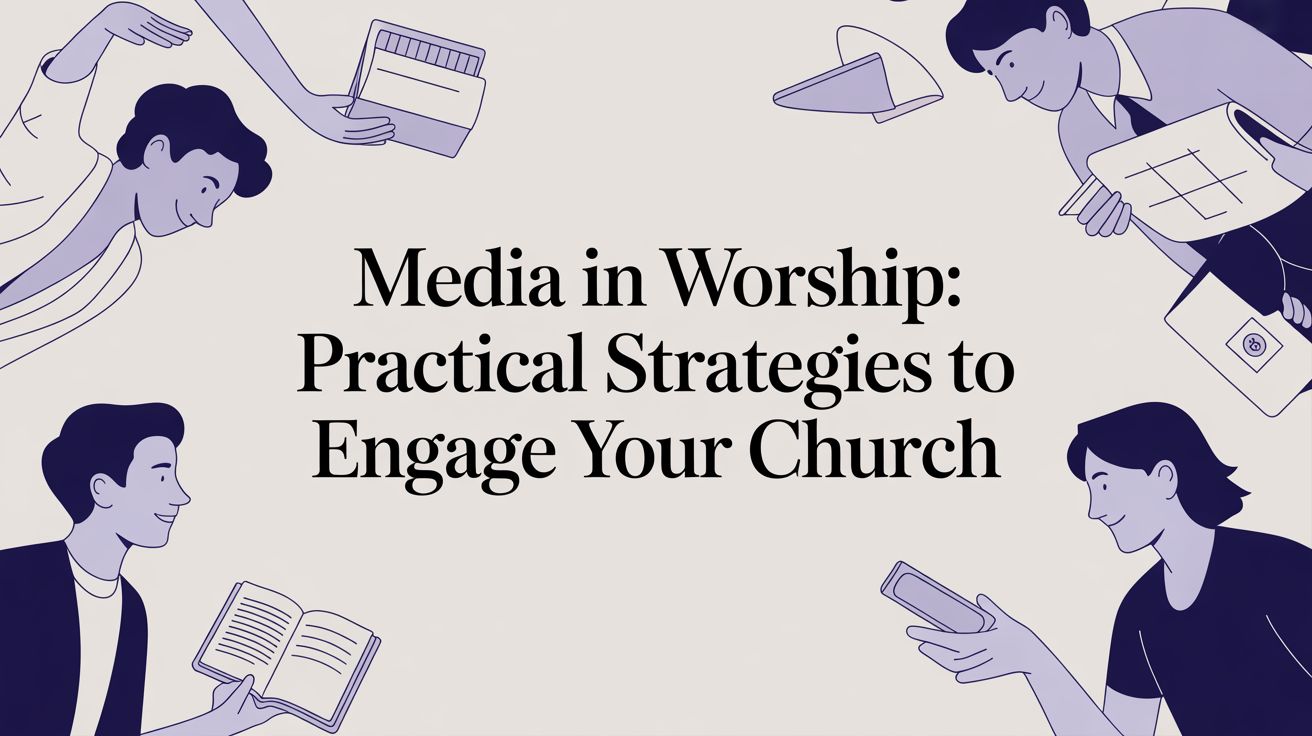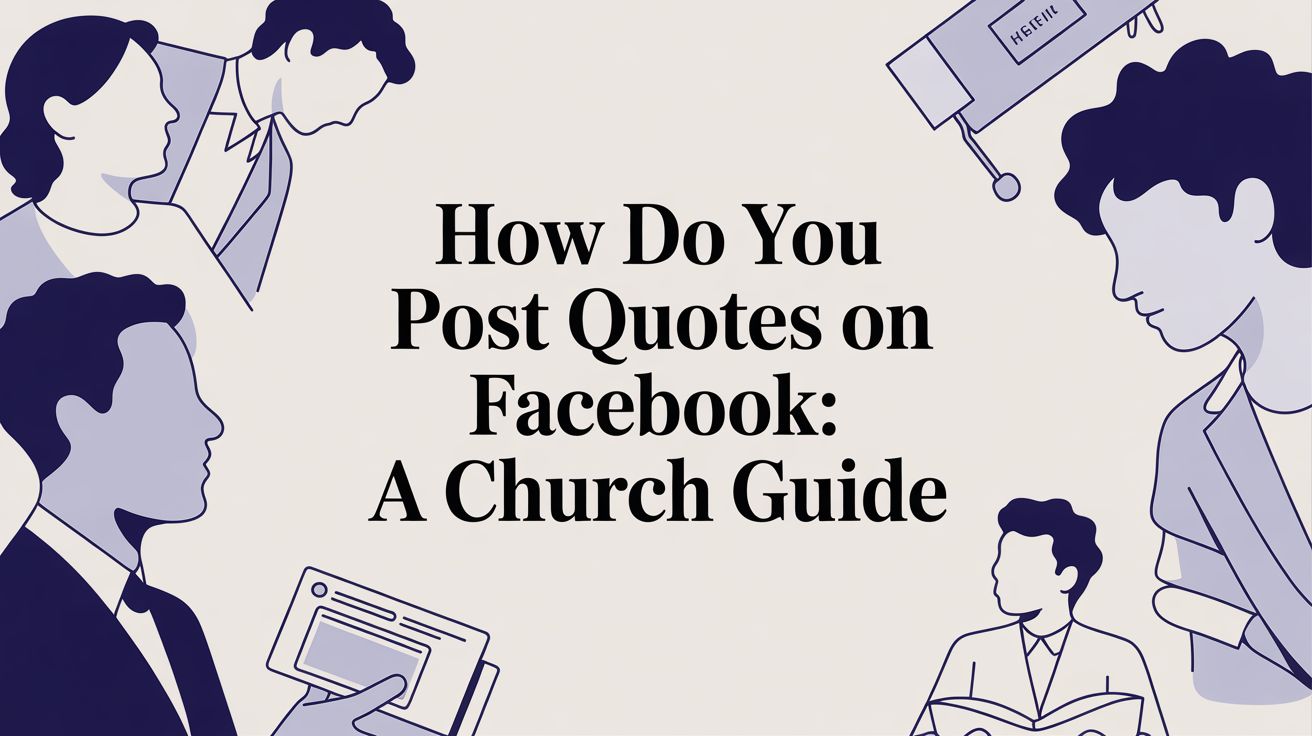At its core, a sermon graphic is a visual aid—think a slide on the screen or a post on Instagram—that drives home a key point from your message. They're essential tools for modern ministry, helping your congregation remember what was said, keeping them engaged, and making sure the sermon’s impact lasts long past Sunday morning.
These graphics are the bridge that turns abstract spiritual ideas into something tangible and memorable.
Why Visuals Matter in Modern Ministry
Let's be honest: we live in a world overflowing with visual information. A spoken message, no matter how powerful, is competing for attention. For a sermon to really stick, its core truths need to be easy to recall long after the service ends.
This is where great church sermon graphics shift from being just a nice-to-have to a must-have. They aren't just decoration; they're powerful communicators of the Gospel, connecting the message they hear with a visual they can hold onto.
When you pair a key scripture or a profound quote with a well-designed graphic, you're helping your congregation lock it in. You're creating a more cohesive worship experience where sight and sound work together, deepening both understanding and emotional connection.

Extending the Message Beyond Sunday
The real magic of these graphics happens outside the sanctuary walls. They become the seeds of your week-long digital discipleship, keeping your ministry's voice active in the daily lives of your people.
This isn't just a trend; it's a significant shift in how churches operate. The market for church presentation software, which is all about creating these visuals, is booming. It's expected to hit $1.2 billion in 2024, showing just how many churches are investing in technology to better engage their congregations.
This is where a tool designed specifically for churches, like ChurchSocial.ai, can feel less like software and more like a ministry partner. It gives any church, regardless of size, the ability to turn one sermon into a full week of engagement. Here’s a quick look at how you can use ChurchSocial.ai to plan and manage your church social media accounts:
- AI Sermon Repurposing: Create AI-generated reels, social posts, and even blog articles right from your sermon transcript.
- Easy Graphic Design: Use our graphic templates and editor to create and post stunning photos and carousels.
- Simple Social Media Management: Our drag-and-drop calendar allows your church to easily manage and update all of your social media accounts.
By turning your key sermon points into shareable church sermon graphics, you are not just decorating a service; you are equipping your congregation with visual reminders of God's truth to carry with them throughout their week.
Ultimately, using visuals well is just good stewardship of the message. It’s about making sure the hard work and prayer you pour into a sermon has the greatest possible impact. For a deeper look at this, check out our complete guide to church visual media.
Foundations of High-Impact Sermon Design
Let's be honest, you don't need a fancy design degree to create powerful church sermon graphics. What you do need is a solid grasp of a few core ideas that put clarity before cleverness. When someone sitting in the back row can instantly get it, the message you're preaching has a much better chance of sticking.
Think of these principles as guardrails, not a cage. The whole point is to support the sermon, not steal the show. This means making sure text is readable from a distance, picking colors that match the feeling of the sermon series, and using images that add meaning instead of just filling space. When all those pieces click into place, your graphics blend seamlessly into the worship experience.
Clarity And Readability First
Before you even think about fonts and colors, ask this one question: is it clear? A stunning design is useless if no one can read the words or the main point gets buried in visual clutter. This is where a simple concept called visual hierarchy comes in.
It just means the most important thing on the screen should look like the most important thing. For example, the title of your sermon series needs to be the biggest, boldest text. Everything else—like the date or a scripture reference—should take a backseat, smaller and less "loud." This simple trick guides the eye and makes sure the core idea lands in a split second.
Your sermon graphic should act like a signpost, not a puzzle. It should point directly to the truth you are sharing, making the journey of understanding easier for everyone in your congregation.
This infographic really breaks down how sermon graphics make an impact by boosting retention, connection, and even how people engage with the message.
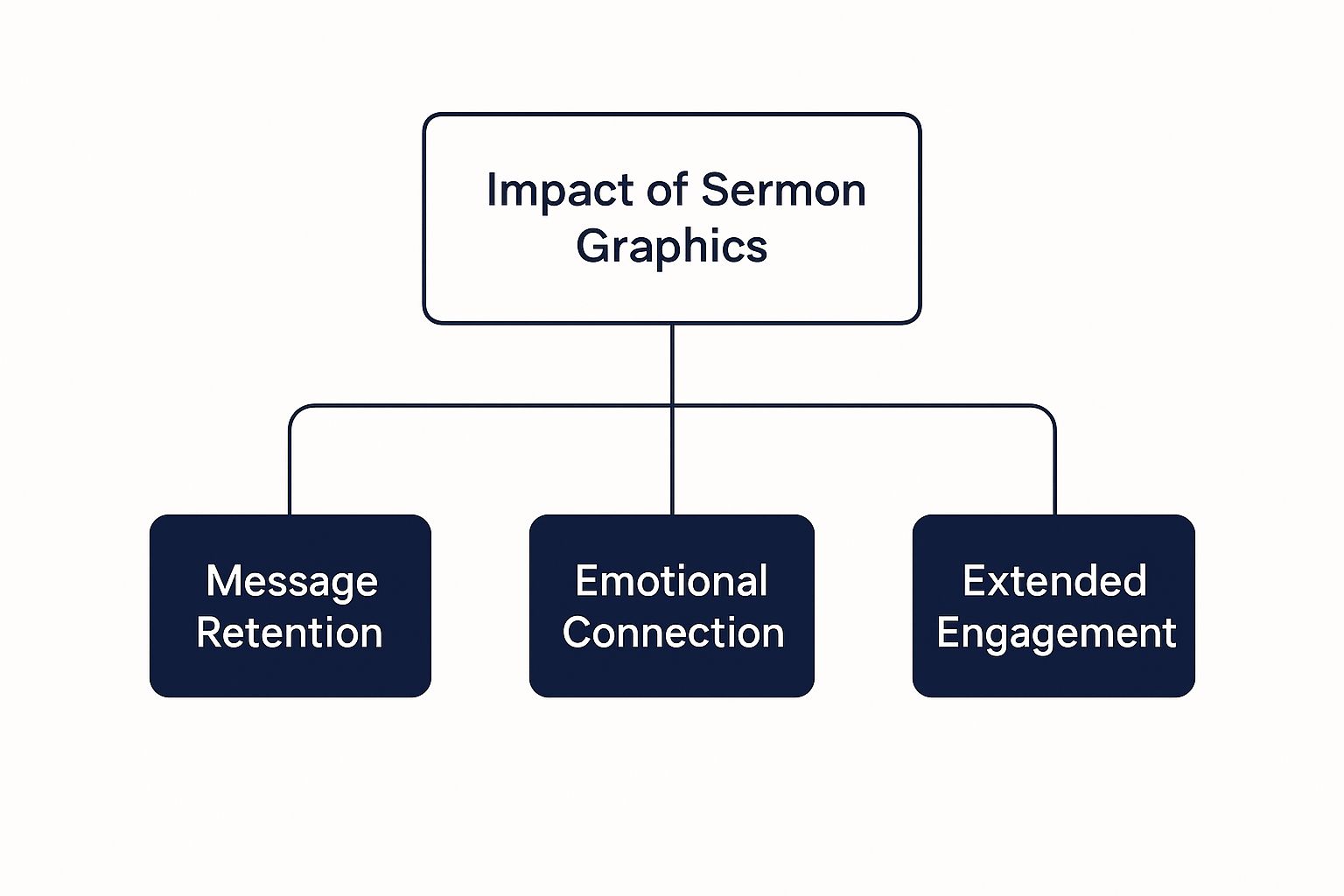
As you can see, the benefits of getting this right ripple out far beyond just the Sunday service itself.
The Power Of Simplicity And Consistency
One of the easiest traps to fall into with church design is trying to cram too much into one graphic. A jumble of different fonts, a rainbow of colors, or too many competing images just creates visual noise. When in doubt, simpler is almost always better.
To help you put these principles into practice, here's a quick cheat sheet comparing some common do's and don'ts.
Design Principles for Impactful Sermon Graphics
This table contrasts effective design practices with common mistakes, helping you create visuals that are clear and engaging.
Sticking to these guidelines will immediately elevate the quality and impact of your designs, making your sermon series feel more professional and cohesive.
For a deeper dive, check out our guide on https://www.churchsocial.ai/blog/graphic-design-for-church. And if you want to make sure the colors you see on your screen are the same ones everyone else sees, mastering color management is a game-changer.
Ultimately, designing for your church is all about clear communication. It’s about creating a visual that helps carry the weight of the message, not add to the noise.
Designing Graphics That Resonate With Your Congregation
Every church has a unique personality. It’s a distinct spirit shaped by its people, its mission, and its community. Your church sermon graphics shouldn't feel like they came from a generic template; they should feel like a natural extension of who you are as a church family.
Creating visuals that truly connect means stepping back to understand the very people you’re called to serve. This isn’t about chasing the latest design trends. It's about intentionally choosing visuals that make your message feel personal and relevant to your audience. A graphic that works wonders for a high-energy student ministry might feel completely out of place during a traditional Sunday service, and that’s perfectly fine.

Know Your Audience
The first step is simple but critical: know who you're designing for. The visual style that speaks to a congregation full of young families and professionals will likely be very different from one that serves an older, more established community. This isn’t about stereotyping—it’s about communicating effectively.
Research actually shows that demographics play a big role in design preferences. For instance, churches serving older adults and families often find that clean, straightforward sermon graphics work best. They meet expectations and keep the focus squarely on the message. On the other hand, churches looking to engage younger generations might lean into more dynamic or artistic visuals.
Ultimately, your design choices should flow from a deep understanding of your congregation. The goal is for your visuals to help, not hinder, the delivery of God's truth.
Guiding Your Visual Direction
To nail down the right visual style for your church, get your team together and ask a few guiding questions:
- Who are we trying to reach? Are we connecting with young families, college students, or our long-standing members?
- What is the tone of this sermon series? Is it reflective and somber? Or is it joyful and celebratory?
- What words describe our church's personality? Are we modern, traditional, vibrant, contemplative, or community-focused?
The answers will give you a rock-solid foundation for your design choices. They'll help you pick the right imagery, fonts, and—most importantly—colors. The colors you choose can instantly set a mood, and having a consistent palette is key to building a recognizable identity. To get you started, check out our detailed guide on selecting impactful church color palettes.
The most effective sermon graphics are not just visually appealing; they are spiritually and culturally relevant to the specific congregation they serve. They feel like they belong.
When you take the time to align your visual style with your church’s unique spirit, your graphics become more than just announcements. They become a meaningful part of the worship experience.
Turning Your Sermon into a Week of Digital Ministry
A powerful sermon shouldn't just end when the final "amen" is said. The truth it carries is meant to resonate all week long, and your church sermon graphics are the key to making that happen.
Think of it this way: your Sunday message is the main event. The digital content that follows is like the small group discussion that helps the message truly sink in. This approach transforms a single sermon into an entire week of digital ministry, keeping your community connected long after they've left the church building.
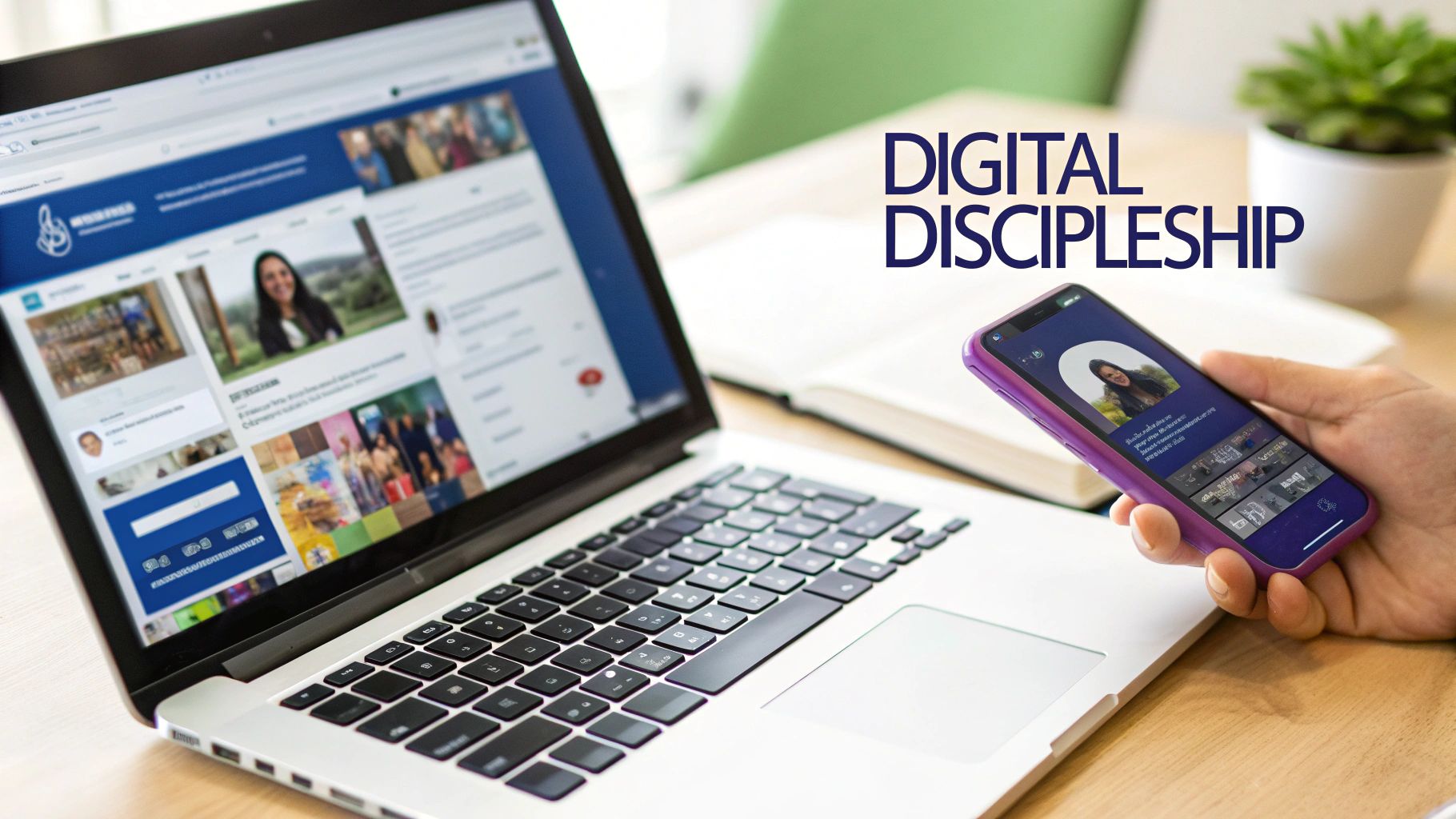
This isn't just a good idea; it’s about meeting people where they are. We're seeing a massive shift in how churches communicate, and digital is at the forefront. Video clips from sermons, especially when paired with sharp graphics, are consistently the most effective way to grab attention online. In fact, for most churches, these clips are their top-performing social media posts.
A Game Plan for Repurposing Your Sermon
The best way to get the most out of your sermons and graphics is to adopt smart content repurposing strategies. You don't have to reinvent the wheel every day. Instead, you pull from the rich material you already prepared for Sunday.
Here’s what a week of digital ministry could look like:
- Monday: Post a visually striking quote card on Instagram with the sermon's big idea. It’s a quick, powerful reminder.
- Tuesday: Share a compelling 60-second reel on Instagram and TikTok showing a key moment from the message.
- Wednesday: Pose a thought-provoking question on Facebook related to the sermon to spark comments and discussion.
- Thursday: Publish a short blog post on your website that dives deeper into one of the sermon's practical applications.
- Friday: Post an Instagram carousel with three to four key takeaways or scriptures, each on its own slide.
This isn't about creating more work; it’s about working smarter. And this is exactly where a tool like ChurchSocial.ai can become a game-changer for your ministry, helping you easily plan and manage your church social media.
From Sermon Transcript to Social Media Calendar
Imagine this: you upload your sermon transcript once and get an entire week's worth of content generated for you. That's the power of ChurchSocial.ai. It was built to handle the heavy lifting so you can focus on people, not pixels.
The goal is to let technology handle the tedious tasks of content creation. This frees up your time and energy to connect with people and build your community—both online and in person.
With ChurchSocial.ai, you can create AI-generated reels, social posts, and blog content right from the sermon transcript. From there, you can use our graphic templates and editor to create and post photos and carousels. Our simple drag-and-drop calendar allows your church to easily manage and update all of your social media, turning a time-consuming chore into an effective discipleship strategy that amplifies your message all week.
Ditch the Chaos, Streamline Your Workflow
Let’s be honest: creating high-quality church sermon graphics and social media content every single week is a grind. It can feel like a full-time job, often falling on dedicated volunteers who pour hours into designing, scheduling, and posting.
This kind of manual effort is a recipe for burnout. When life gets busy, consistency is the first thing to go. But what if you could reclaim those hours? What if you could manage your church’s entire online presence from one simple, intuitive place?
This is where having a single, unified system changes everything. Instead of juggling a dozen different apps for design, scheduling, and content ideas, you can bring it all under one roof. This doesn’t just save a massive amount of time; it ensures your ministry maintains a polished and cohesive voice across every channel.
From Complex to Cohesive in One Place
Imagine having one central hub for all your creative needs. With a tool like ChurchSocial.ai, that idea becomes a reality. The platform is built specifically for the unique demands of ministry, putting powerful tools directly into your hands without a steep learning curve.
You can go from creating a graphic to scheduling it for the entire week in just a few clicks. This consolidated workflow gets rid of the friction that so often slows down church communications teams. The goal is to make content creation feel less like a chore and more like a natural extension of your ministry.
Here’s a peek at the ChurchSocial.ai dashboard, where you can manage your calendar, create content, and see everything at a glance.
This kind of unified view helps you see your entire content strategy from 30,000 feet, making sure you have a balanced mix of posts that engage and inspire your community.
A Smarter Way to Manage Your Calendar
One of the best features of a unified platform is the simple drag-and-drop calendar. It lets you plan and schedule content weeks in advance, giving you peace of mind and freeing you from the pressure of last-minute posting.
But the real magic comes from its smart integrations.
By connecting directly with tools your church already uses, like Planning Center, ChurchSocial.ai can automatically create content for upcoming events. This saves you from manually entering information and designing graphics from scratch.
Think about that—less administrative work and more time for actual ministry. Our platform integrates with Planning Center and other church calendars to create content for events, turning your church calendar into a proactive content engine.
Here’s how a unified platform like ChurchSocial.ai helps churches plan and manage their social media accounts:
- Professional Graphic Templates: Use our graphic templates and editor to create and post photos and carousels without any design experience.
- AI-Powered Content Creation: Go beyond graphics. Create AI-generated reels, social posts, and blog content directly from your sermon transcript.
- Automated Event Promotion: We integrate with Planning Center and other church calendars to create content for events, services, and small groups automatically.
By bringing all these functions together, you can reduce volunteer burnout, maintain a high standard of quality, and build a consistent online ministry. This isn't just about posting pretty pictures; it’s about creating an efficient system that supports your church's mission to reach people.
Your Top Questions About Sermon Graphics, Answered
Jumping into the world of church communications, especially with sermon graphics and social media, can feel like a lot. Let's walk through some of the most common questions we hear from church leaders and volunteers, giving you some straightforward answers to help you get started.
Can We Really Make Good Graphics Without a Designer?
Yes, you absolutely can. And honestly, most churches don't have a professional designer on the payroll. That's the whole point of tools built specifically for ministry—they make excellence easy for everyone.
You don't need to become a Photoshop wizard overnight. Platforms like ChurchSocial.ai are designed to close that gap. They give you a library of professional templates and a super simple editor. This means anyone on your team, whether it's the lead pastor or a dedicated volunteer, can create sharp, compelling visuals that get the message across. No design degree necessary.
How Do We Keep All Our Graphics Looking Consistent?
Consistency is huge. It’s what helps people instantly recognize your church in a crowded social media feed and builds a sense of trust. The trick is to create a simple visual identity and then just stick to it.
This doesn't have to be some massive branding project. A basic style guide with your church's main colors, a couple of key fonts, and your logo is all you need to get started.
When you use a tool like ChurchSocial.ai, you can quickly tweak any template to match your church’s look. This ensures that every single graphic—from the sermon series art to a potluck announcement—feels like it’s coming from the same place.
A consistent visual identity isn't just about looking professional. It creates a familiar, trustworthy presence for your church online, making your message that much more powerful.
How Much Time Will This Actually Take Every Week?
If you're trying to do everything from scratch, it's not crazy for content creation and scheduling to eat up a few hours every single week. For small teams or volunteers, that's a massive time commitment. But with the right system in place, you can slash that time dramatically.
The secret is a streamlined workflow. For instance, with ChurchSocial.ai, you can drop in a single sermon transcript and let the AI generate an entire content plan. From there, the graphic editor makes creating visuals a breeze, and our simple drag-and-drop calendar allows churches to easily manage and update all of their social media. You can genuinely get a full week of high-quality content planned and scheduled in less than an hour. That’s time you get back to focus on people, not pixels.
Ready to stop the content grind and elevate your church's online presence? With ChurchSocial.ai, you can turn one sermon into a week of engaging content—from AI-generated reels to professional graphics and automated scheduling. See just how simple it is to plan and manage your church's social media. Start simplifying your ministry's workflow today at https://churchsocial.ai.

